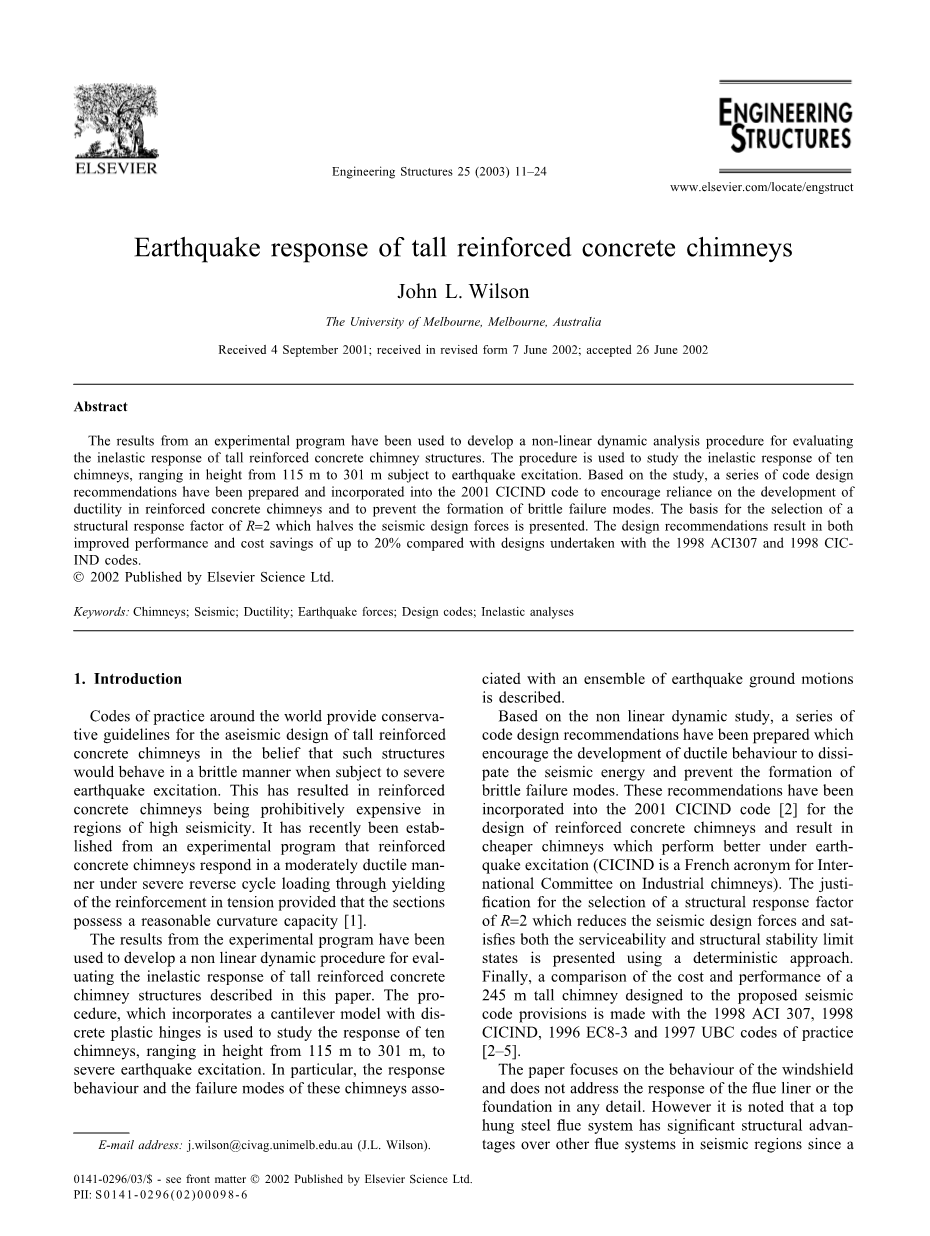

英语原文共 14 页,剩余内容已隐藏,支付完成后下载完整资料
Engineering Structures 25 (2003) 11–24
www.elsevier.com/locate/engstruct
Earthquake response of tall reinforced concrete chimneys
John L. Wilson
The University of Melbourne, Melbourne, Australia
Received 4 September 2001; received in revised form 7 June 2002; accepted 26 June 2002
Abstract
The results from an experimental program have been used to develop a non-linear dynamic analysis procedure for evaluating the inelastic response of tall reinforced concrete chimney structures. The procedure is used to study the inelastic response of ten chimneys, ranging in height from 115 m to 301 m subject to earthquake excitation. Based on the study, a series of code design recommendations have been prepared and incorporated into the 2001 CICIND code to encourage reliance on the development of ductility in reinforced concrete chimneys and to prevent the formation of brittle failure modes. The basis for the selection of a structural response factor of R=2 which halves the seismic design forces is presented. The design recommendations result in both improved performance and cost savings of up to 20% compared with designs undertaken with the 1998 ACI307 and 1998 CICIND codes.
2002 Published by Elsevier Science Ltd.
Keywords: Chimneys; Seismic; Ductility; Earthquake forces; Design codes; Inelastic analyses
1. Introduction
Codes of practice around the world provide conservative guidelines for the aseismic design of tall reinforced concrete chimneys in the belief that such structures would behave in a brittle manner when subject to severe earthquake excitation. This has resulted in reinforced concrete chimneys being prohibitively expensive in regions of high seismicity. It has recently been established from an experimental program that reinforced concrete chimneys respond in a moderately ductile manner under severe reverse cycle loading through yielding of the reinforcement in tension provided that the sections possess a reasonable curvature capacity [1].
The results from the experimental program have been used to develop a non linear dynamic procedure for evaluating the inelastic response of tall reinforced concrete chimney structures described in this paper. The procedure, which incorporates a cantilever model with discrete plastic hinges is used to study the response of ten chimneys, ranging in height from 115 m to 301 m, to severe earthquake excitation. In particular, the response behaviour and the failure modes of these chimneys asso-
ciated with an ensemble of earthquake ground motions is described.
Based on the non linear dynamic study, a series of code design recommendations have been prepared which encourage the development of ductile behaviour to dissipate the seismic energy and prevent the formation of brittle failure modes. These recommendations have been incorporated into the 2001 CICIND code [2] for the design of reinforced concrete chimneys and result in cheaper chimneys which perform better under earthquake excitation (CICIND is a French acronym for International Committee on Industrial chimneys). The justification for the selection of a structural response factor of R=2 which reduces the seismic design forces and satisfies both the serviceability and structural stability limit states is presented using a deterministic approach. Finally, a comparison of the cost and performance of a 245 m tall chimney designed to the proposed seismic code provisions is made with the 1998 ACI 307, 1998 CICIND, 1996 EC8-3 and 1997 UBC codes of practice
[2–5].
|
J.L. Wilson / Engineering Structures 25 (2003) 11–24
|
The paper focuses on the behaviour of the windshield and does not address the response of the flue liner or the foundation in any detail. However it is noted that a top hung steel flue syste
全文共58886字,剩余内容已隐藏,支付完成后下载完整资料
资料编号:[144086],资料为PDF文档或Word文档,PDF文档可免费转换为Word


